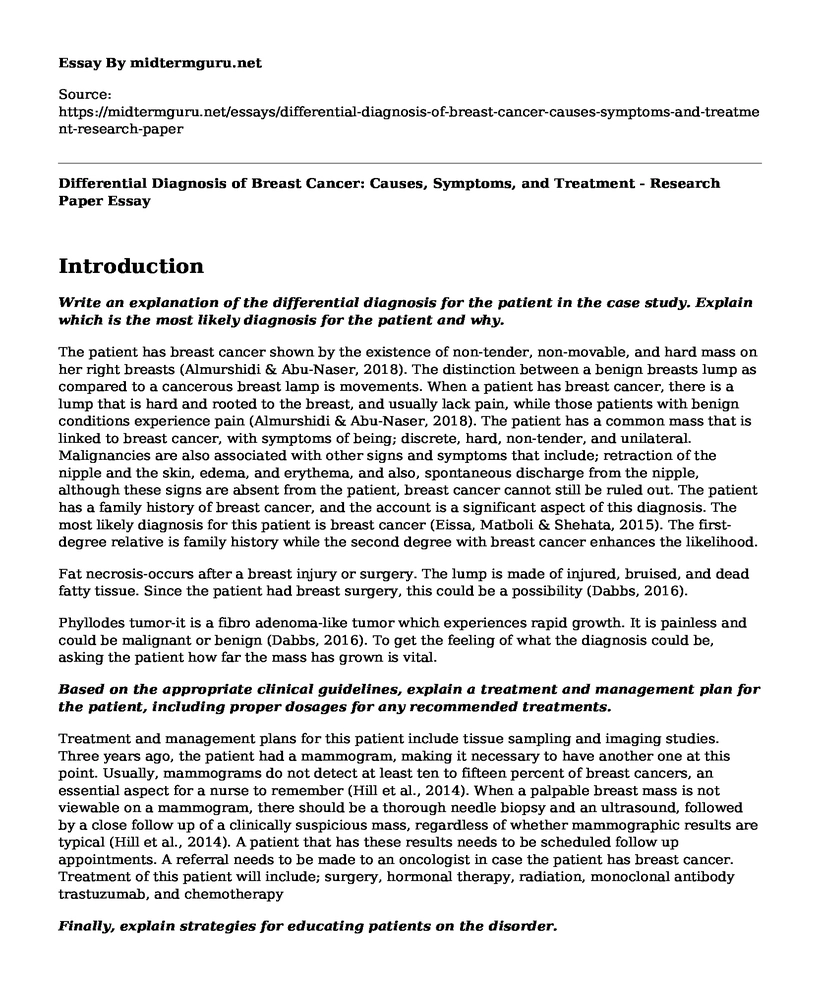Introduction
Write an explanation of the differential diagnosis for the patient in the case study. Explain which is the most likely diagnosis for the patient and why.
The patient has breast cancer shown by the existence of non-tender, non-movable, and hard mass on her right breasts (Almurshidi & Abu-Naser, 2018). The distinction between a benign breasts lump as compared to a cancerous breast lamp is movements. When a patient has breast cancer, there is a lump that is hard and rooted to the breast, and usually lack pain, while those patients with benign conditions experience pain (Almurshidi & Abu-Naser, 2018). The patient has a common mass that is linked to breast cancer, with symptoms of being; discrete, hard, non-tender, and unilateral. Malignancies are also associated with other signs and symptoms that include; retraction of the nipple and the skin, edema, and erythema, and also, spontaneous discharge from the nipple, although these signs are absent from the patient, breast cancer cannot still be ruled out. The patient has a family history of breast cancer, and the account is a significant aspect of this diagnosis. The most likely diagnosis for this patient is breast cancer (Eissa, Matboli & Shehata, 2015). The first-degree relative is family history while the second degree with breast cancer enhances the likelihood.
Fat necrosis-occurs after a breast injury or surgery. The lump is made of injured, bruised, and dead fatty tissue. Since the patient had breast surgery, this could be a possibility (Dabbs, 2016).
Phyllodes tumor-it is a fibro adenoma-like tumor which experiences rapid growth. It is painless and could be malignant or benign (Dabbs, 2016). To get the feeling of what the diagnosis could be, asking the patient how far the mass has grown is vital.
Based on the appropriate clinical guidelines, explain a treatment and management plan for the patient, including proper dosages for any recommended treatments.
Treatment and management plans for this patient include tissue sampling and imaging studies. Three years ago, the patient had a mammogram, making it necessary to have another one at this point. Usually, mammograms do not detect at least ten to fifteen percent of breast cancers, an essential aspect for a nurse to remember (Hill et al., 2014). When a palpable breast mass is not viewable on a mammogram, there should be a thorough needle biopsy and an ultrasound, followed by a close follow up of a clinically suspicious mass, regardless of whether mammographic results are typical (Hill et al., 2014). A patient that has these results needs to be scheduled follow up appointments. A referral needs to be made to an oncologist in case the patient has breast cancer. Treatment of this patient will include; surgery, hormonal therapy, radiation, monoclonal antibody trastuzumab, and chemotherapy
Finally, explain strategies for educating patients on the disorder.
A patient with breast cancer should be educated on the essence of ensuring they follow up visits. During follow-ups, results and other follow up care is discussed. Patients education should also include; educational materials and sites which can be accessed online, relative to the diagnosis. A nurse needs to provide alternative therapy and referrals to support groups, and additional information on alternative treatment in case complications arise (Almurshidi & Abu-Naser, 2018).
Conclusion
Breast changes are common, and most times, they are not cancer. There are some follow-up tests used to diagnose breast conditions and the best treatments for specific conditions. While a woman can feel some breast conditions, some are identified by a healthcare provider, while others during imaging procedures, MRI, ultrasound, and mammogram (Dabbs, 2016). Most changes in the breast include; a firm feeling or a lump in the breast or under the arms, which come in different sizes and shapes. Nipples could also change and have a discharge, which comes out in distinct textures and colors, and could be caused by birth control pills, infections and certain medicines (Eissa, Matboli & Shehata, 2015). The skin could get red and itchy, dimpled, puckered, and scaled.
References
Almurshidi, S. H., & Abu-Naser, S. S. (2018). Expert System For Diagnosing Breast Cancer. Al-Azhar University, Gaza, Palestine.
Dabbs, D. J. (2016). Breast Pathology E-Book. Elsevier Health Sciences.
Eissa, S., Matboli, M., & Shehata, H. H. (2015). Breast tissue-based microRNA panel highlights microRNA-23a and selected target genes as putative biomarkers for breast cancer. Translational Research, 165(3), 417-427.
Hill, D. A., Horick, N. K., Isaacs, C., Domchek, S. M., Tomlinson, G. E., Lowery, J. T., ... & Plon, S. E. (2014). Long-term risk of medical conditions associated with breast cancer treatment. Breast cancer research and treatment, 145(1), 233-243.
Cite this page
Differential Diagnosis of Breast Cancer: Causes, Symptoms, and Treatment - Research Paper. (2023, Jan 24). Retrieved from https://midtermguru.com/essays/differential-diagnosis-of-breast-cancer-causes-symptoms-and-treatment-research-paper
If you are the original author of this essay and no longer wish to have it published on the midtermguru.com website, please click below to request its removal:
- Whether Human Immunodeficiency Infection Causes Aids - Paper Example
- Pathophysiology of Gastric Acid Stimulation and Production - Essay Sample
- Maximizing Healthcare Performance: The Evolution from Triple to Quadruple Aim - Research Paper
- Nurses Unite to Change Healthcare Policies: A Call for Action - Essay Sample
- Organizational Ethics: Key Considerations for Decision Making - Essay Sample
- Bob Selling Drugs Illegally in US: Potential Harm to Consumers - Essay Sample
- Understanding Internal vs. External Evidence in Nursing - Research Paper







